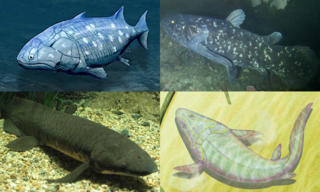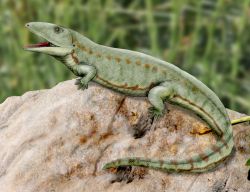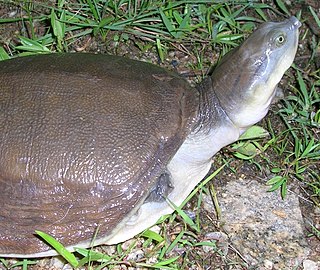
The Carboniferous is a geologic period and system of the Paleozoic that spans 60 million years from the end of the Devonian Period 358.9 Ma to the beginning of the Permian Period, 298.9 Ma. In North America, the Carboniferous is often treated as two separate geological periods, the earlier Mississippian and the later Pennsylvanian.
The PaleozoicEra is the first of three geological eras of the Phanerozoic Eon. Beginning 538.8 million years ago (Ma), it succeeds the Neoproterozoic and ends 251.9 Ma at the start of the Mesozoic Era. The Paleozoic is subdivided into six geologic periods :

Sarcopterygii — sometimes considered synonymous with Crossopterygii — is a taxon of the bony fish known as the lobe-finned fish or sarcopterygians, characterised by prominent muscular limb buds (lobes) within the fins, which are supported by articulated appendicular skeletons. This is in contrast to the other clade of bony fish, the Actinopterygii, which have only skin-covered bony spines (lepidotrichia) supporting the fins.

"Labyrinthodontia" is an informal grouping of extinct predatory amphibians which were major components of ecosystems in the late Paleozoic and early Mesozoic eras. Traditionally considered a subclass of the class Amphibia, modern classification systems recognize that labyrinthodonts are not a formal natural group (clade) exclusive of other tetrapods. Instead, they consistute an evolutionary grade, ancestral to living tetrapods such as lissamphibians and amniotes. "Labyrinthodont"-grade vertebrates evolved from lobe-finned fishes in the Devonian, though a formal boundary between fish and amphibian is difficult to define at this point in time.

Sigillaria is a genus of extinct, spore-bearing, arborescent lycophyte, known from the Carboniferous and Permian periods. It is related to the more famous Lepidodendron, and more distantly to modern quillworts.

Lissemys is a genus of softshell turtles in the subfamily Cyclanorbinae of the family Trionychidae. The genus is indigenous to southern Asia.

Lunaspis is an extinct genus of armor-plated petalichthyid placoderm fish that lived in shallow marine environments of the Early Devonian period, from approximately 409.1 to 402.5 million year ago. Fossils have been found in Germany, China and Australia. There are three different identified species of within the genus Lunaspis: L. broilii, L. heroldi, and L. prumiensis.

Campylocephalus is a genus of eurypterid, a group of extinct aquatic arthropods. Fossils of Campylocephalus have been discovered in deposits ranging from the Carboniferous period in the Czech Republic to the Permian period of Russia. The generic name is composed of the Greek words καμπύλος (kampýlos), meaning "curved", and κεφαλή (kephalē), meaning "head".

Adelophthalmus is a genus of eurypterid, an extinct group of aquatic arthropods. Fossils of Adelophthalmus have been discovered in deposits ranging in age from the Early Devonian to the Early Permian, which makes it the longest lived of all known eurypterid genera, with a total temporal range of over 120 million years. Adelopththalmus was the final genus of the Eurypterina suborder of eurypterids and consisted the only known genus of swimming eurypterids from the Middle Devonian until its extinction during the Permian, after which the few surviving eurypterids were all walking forms of the suborder Stylonurina.
The Portland Formation is a geological formation in Connecticut and Massachusetts in the northeastern United States. It dates back to the Early Jurassic period. The formation consists mainly of sandstone laid down by a series of lakes and the floodplain of a river. The sedimentary rock layers representing the entire Portland Formation are over 4 kilometres (2.5 mi) thick and were formed over about 4 million years of time, from the Hettangian age to the late Hettangian and Sinemurian ages.
Agecephalichthys is an extinct genus of prehistoric freshwater "palaeonisciform" bony fish that lived during the Anisian age in what is now New South Wales, Australia.

Acrolepis is an extinct genus of prehistoric marine bony fish that lived from the Tournaisian stage of the Mississippian to the late Permian epoch. Some species from the Early Triassic of Tasmania are also ascribed to Acrolepis.
Macromerion is an extinct genus of non-mammalian synapsids, specifically Pelycosaurs, in the family Sphenacodontidae from Late Carboniferous deposits in the Czech Republic. It was named as a species of Labyrinthodon in 1875 and as its own genus in 1879.

Lissodus is an extinct genus of hybodont. While fossils attributed to this genus are known spanning from the latest Devonian (Famennian) to the very end of the Cretaceous (Maastrichtian), others consider the genus to have a more narrow range, spanning from the Early Triassic to the end of the Early Cretaceous (Albian). Lissodus is often placed in the family Lonchidiidae, though other authors consider it incertae sedis within Hybodontiformes. Lonchidion has often been regarded as synonymous, but many recent authors consider it to be a distinct but closely related genus.
Palatinerpeton is an extinct genus of temnospondyl amphibian. Fossils have been found in the Lauterecken-Odernheim Formation of Germany.
Micromomyidae (Micromomids) is a family of extinct plesiadapiform mammals that include some of the earliest known primates. The family includes five genera that lived from the Paleocene epoch into the early Eocene epoch.

Eumaiochoerus is an extinct genus of even-toed ungulates that existed during the Miocene in Italy.

Adelophthalmidae is a family of eurypterids, an extinct group of aquatic arthropods. Adelophthalmidae is the only family classified as part of the superfamily Adelophthalmoidea, which in turn is classified within the infraorder Diploperculata in the suborder Eurypterina.

Ceratodontiformes is the only extant order of lungfish, containing the families Neoceratodontidae, Lepidosirenidae, and Protopteridae as well as many other extinct groups. Members of this group are the only lungfish known to have survived the Permian-Triassic extinction event. Although lungfish originated in marine environments, the Ceratodontiformes have been an exclusively freshwater group since the Carboniferous.
Alligator hailensis, or Haile alligator, is a large, extinct species of Alligator known from the early Pleistocene of Florida. It is named after the town of Haile, Florida, where it was found. Its age and skeletal morphology is intermediate between the geologically older Alligator mefferdi and the modern American alligator, making it a transitional fossil.











